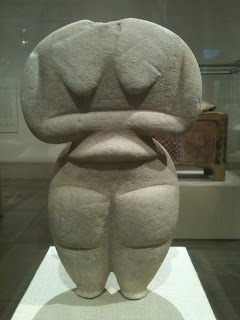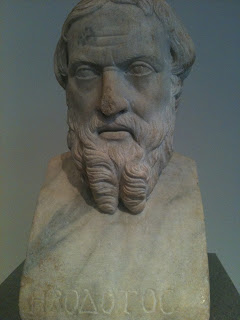Marble Female figure
Cycladic, Final Neolithic,
Ca. 4500-4000 B.C
Greek and Roman Art
This section of the Metropolitan has recently experienced a 15 year renovation. It has a completely different feel then the Egyptian section, it feels more open, like a breath of fresh air. But sometimes that makes it slightly more difficult to stay focused. I decided to go for a guided tour. A guided tour might seem slightly old fashioned at times, but if you want to learn essentials quickly, then it can be quite a treat. After the tour I went back through the immense collection and took pictures of some of the highlights that I wanted to share with you.
Marble Female figure
Cycladic, Final Neolithic,
Ca. 4500-4000 B.C
This is a gorgeous fertility sculpture from the Cyclades. Cyclades is the Greek Island group in the Aegean sea (South-east of the mainland). Interesting the focus on the butt (I adore the idea), nowadays would you say it is breast's or butt's that takes the focus of a fertility symbol?
Marble seated harp player
Cycladic, late Early Cycladic I - Early Cycladic II
ca. 2800 - 2700 B.C.
One of the earliest sculptures of a musician, with perfectly molded arms and hands.
Terracotta vase in the form of a bull´s head
Minoan, Late Minoan II, ca. 1450-1400 B.C.
Minoan Art (Greek) time is represented by gem engraving, metalwork, stoneworking, and pottery, also mostly found in burial sites.
This terracotta vase is a sort of offering device to the Gods. Where it would be filled with liquid and poured out through the animals muzzle.
Terracotta stirrup jar with octopus
Helladic (Mycenaean) late Helladic IIIC
Ca. 1200-1100 B.C.
Having been overwhelmed with these types of pottery in Greece, that is being copied over and over again. I must admit it is hard to bring out fascination for these again. But the Octopus legs...
Terracotta amphora (jar)
Greek, Attic, red figure, ca 490 B.C.
...And learning about the difficult and intricate makings of these pots, won me over...
Until...:
Marble Statue of a Kouros (youth)
Greek, Attic, ca. 590-580 B.C.
I ended up in front of one of the earliest marble statues of human figures carved in Attica.
Pair of eyes
Bronze, marble, frit, quartz and obisidian
Probably Greek, 5th Century B.C. or later
Eyes for Greek and Roman statues were usually made separately and put into prepared sockets later.
Quite a haunting pair. (inspiration for Stanley Kubrick's film "A clockwork orange?)
Glass vessels
Eastern Mediterranean, core-formed, Mediterranean Group.
5th Century B.C.
Since I am in a comparative mood, I will continue here with these gorgeous vessels. If you look closely do they remind you of the patterns that the designer Missoni uses?
Set of bronze armor
Greek, South Italian, Apulian, ca. 330 B.C.
Ancient Armor are at times quite representative of the art form at the time.
Gold Olive wreath
Greek, 4th Century B.C.
Funerary wreath was a popular burial offering. But they could also be worn at festivals and presented as prizes. Both Men and Women would wear gold wreaths in the ancient Greece.

Gold openwork hairnet with medallion
Greek, Ptolemaic, ca. 200 - 150 B.C.
This hairnet is actually quite large, which tells you how long and thick hair (or wigs) the women must have had.
Part of three wall paintings from a reception hall
roman, late Republican, ca. 50-40 B.C.
These probably represented a dynastic marriage. I only have the first panel here, with the probably important lady playing the stringed instrument and the child part of the ruling family.
Wall paintings from a Cubiculum Nocturnum (Bedroom)
Roman, late Republican ca. 50-40 B.C.
The technique here is called the fresco technique, you can see an insert bellow. This specific large wall fresco is among the most complete and important that has survived. The room has been reconstructed to get a more realistic impression, and it does look quite impressive.
Marble bust of Herodotos (ca. 484-424 B.C.)
Roman, Imperial period, 2nd century A.D.
Copy of a Greek bronze statue of the 1st half of the 4th century B.C.
This is the man best known for being the "Father of History", by the way he described the origins of the Greeco-Persian Wars. Systematically and factually.
Marble funerary altar of Cominia Tyche
Roman, Flavian or Trajanic period, ca A.D. 90-100
This is the front of an altar to honor a woman and her death at 27 years old. She wears a fashionable hairstyle popular among the imperial court in the late Flavian period (A.D. 69-96)
Couch and footstool with bone carvings and glass inlays
Roman 1st-and 2nd Century A.D.
To make this a representable piece of furniture they have brought together many similar pieces and reconstructed them to this one. You can't see it from this picture, but the couch has very long legs and therefore seem slightly awkward to us today, but nonetheless a beautiful piece.
The Roman Mosaic from Lod, Israel
A.D. 300
This huge mosaic floor was uncovered in 1996, but not lifted from the ground before 2009.
It is exhibited to the public for the first time at the Met. It will only be at the Met until April 2011 so if you want to see it you have to hurry.
Bronze Chariot inlaid with Ivory
Etruscan 2nd quarter of 6th Century B.C.
The Etruscans was from the part of Italy we now know as Tuscany, they were heavily inspired by Greecian art since they had a strong trading relationship.
I have actually been to one of the Etruscian museums outside of Firenze a long time ago and I remember how in awe I was, but how I wish I remember what the place was called....
This spectacular chariot has a prominent place on top of the mezzanine and with that I leave the Romans and the Greek for today.
Tonight I will move to the Contemporary world and visit the opening of Charles LeDray's opening at the Whitney tonight. On with my Armory and mascara!
With Love
Kristin



















This is utter magic! Thank you so much for sharing the highlights (I love the idea of the guided tour as a treat :)). It's one of my favorite Met sections, but I haven't been in so long. The eyes are stunning, and I also love the musician figure and mosaic floor.
ReplyDeleteAnd so lucky you've been to a wholly Etruscan museum! I'm fascinated by them, and wish I'd seen more Etruscan art/artifacts the times I'd visited Italy. Have a fab time at the Whitney!
Thanks for sharing. I can't wait to move to New York so I can stop by the Met as often as possible.
ReplyDeleteThat is so very interesting...My favourite is the Terracotta amphora...Its amazing to read about those treasures:)
ReplyDeleteKisses, my dear
That bulls head really stands out. :)SarahD
ReplyDeleteI ususally skip this part of the museum but I do enjoy looking at the jewelry- those eyes are pretty cool too- but I'm a contemporary art girl- I do love poetry and philosophy from this time period though.
ReplyDeleteWow! That is a lot of terrific art. What an experience.
ReplyDeleteThe guided tour sounds like a good idea just to get a grasp. I imagine it's hard to take it all in.
Thanks for the great review. I'm always delighted to visit with you here.
old sculptures and vases totally intrigue me
ReplyDeleteThe Minoan art and the couch and stool are gorgeous!
ReplyDeleteOoh thanks for the recommendation - the Silver Spoon cookbook is on my list!
Gorgeous post, darling! I love the Met!
ReplyDeleteThat gold wreath is amazing!
xoxox,
CC
Thank you all! I am looking forward to my next "Live-in" Section at the Met on Friday hopefully!
ReplyDeletei remember learning about all this in my first art history class!
ReplyDeleteThat's it Kristin, you've inspired me to go to the Met this weekend....after seeing Sugimoto @ Pace, that is.
ReplyDelete